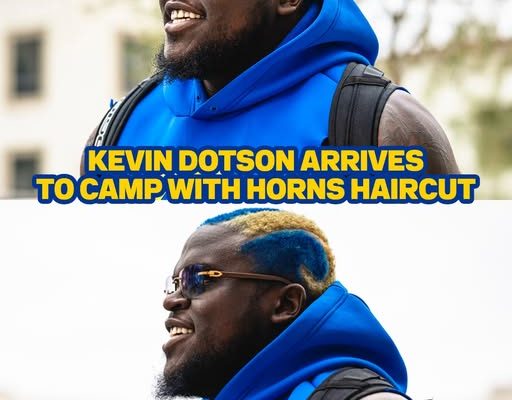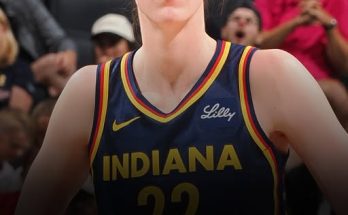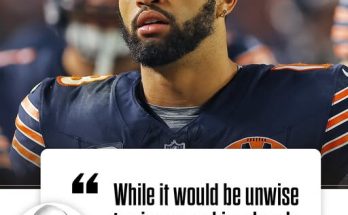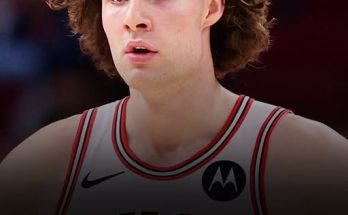At the intersection of personal expression and professional dedication, stories like Kevin Dotson’s recent appearance at training camp emerge as powerful emblems of what it means to fully buy into a team’s culture. When Dotson walked into camp with his hair dyed in the vivid colors of team pride, it wasn’t just a fun stylistic choice—it was a reflection of something deeper, something emotional, even symbolic. It was a message to his teammates, coaches, and fans that he’s all in. In an era where commitment can feel fleeting, especially in professional sports where trades, contracts, and business decisions often supersede loyalty, Dotson’s move stands as a rare and refreshing example of dyed-in-the-wool devotion—quite literally.
Dotson, a formidable offensive lineman with a reputation for being both physical and technically sound, has always played with a visible passion on the field. But what he showcased at training camp this year was more than just hustle in drills or intensity in the weight room. With his hair bleached and colored in bold streaks that matched the team’s signature hues, he made a loud and clear statement without saying a single word: he’s not just playing for a paycheck; he’s playing for something he believes in. In professional sports, actions often speak louder than words, and Dotson’s visual gesture carried the kind of emotional resonance that can uplift a locker room, energize a fan base, and set a tone for a season.
What’s especially powerful about Dotson’s display is that it goes beyond superficial flair. Many athletes have shown off eccentric fashion or haircuts for personal branding or social media attention. But those who know Dotson—or have followed his journey through college and into the NFL—understand that this gesture aligns with the player he’s always been: passionate, loyal, and unafraid to show emotion. He’s a grinder who has worked for everything he’s achieved, and for someone like that, such a colorful expression isn’t about vanity. It’s about identity.
Hair has long served as a canvas for athletes to display their individuality. From Dennis Rodman’s kaleidoscope of styles in the 1990s to Odell Beckham Jr.’s iconic blonde curls, the link between appearance and message is undeniable in sports. Yet, Dotson’s choice feels different in tone—it’s not just about him; it’s about the team. When he colored his hair in alignment with the team colors, he visually embedded himself into the brand and brotherhood. For a team seeking to cultivate culture and cohesion, that matters. It’s leadership through symbolism. It tells younger players that buying in isn’t just about memorizing the playbook—it’s about embodying the spirit.
This seemingly small act of dying one’s hair takes on greater meaning in the context of NFL training camps. These camps are grueling, and they mark the real beginning of football’s mental and physical grind. For veterans and rookies alike, this is where culture is shaped, camaraderie is built, and roster spots are won. The tempo is high, the margins are razor-thin, and the emotional stakes are enormous. Any display of solidarity and passion, no matter how aesthetic, becomes part of a larger motivational ecosystem.
For Dotson, a lineman who often goes unnoticed on the stat sheet but is critical to every offensive success, standing out in this way may also serve another function: representation. Offensive linemen don’t get much spotlight. They rarely appear in highlight reels unless a mistake is made. But the dye in Dotson’s hair makes him impossible to overlook—and in a way that isn’t selfish or disruptive. It’s celebratory. It puts a spotlight not just on himself but on the culture he’s promoting. And that’s a culture of heart, buy-in, and full-throttle belief in the mission.
Moreover, team culture isn’t built overnight. It’s the product of intentional acts, shared experiences, mutual respect, and visible commitment. That last piece—visible commitment—is what Dotson’s hairstyle symbolizes so well. It’s one thing to say “I’m all in.” It’s another thing to physically manifest it for everyone to see. And teammates notice that. Coaches notice that. Even players in position battles, who might be fighting Dotson for a starting role, see that and gain a sense of what it means to truly commit. That’s how identity spreads within an organization.
His choice to showcase team colors on his head also connects to a broader, more human question: how do people show allegiance? In sports, there’s an unspoken demand for loyalty, but not always an open avenue for expressing it. Fans have jerseys and face paint. Players have celebrations and interviews. But hair—especially when styled boldly—is an unmissable, living declaration. It walks with you into the locker room, into the huddle, onto the field. It becomes part of your persona.
This kind of expression also carries risk. What if Dotson doesn’t perform up to expectations? What if the team struggles this season? Public displays of allegiance can backfire when outcomes don’t match the intensity of commitment. But therein lies another powerful aspect of Dotson’s gesture—it’s courageous. It’s a willingness to stand up and say, “I believe,” even when there are no guarantees. That vulnerability is rare in a sport where players often guard themselves emotionally as a form of professional survival. Dotson’s decision bucks that norm, and in doing so, humanizes the athlete in a way fans rarely get to see.
From a psychological standpoint, symbolic gestures like hair dye can also have tangible impacts on performance. It’s not unlike a pre-game ritual or wearing lucky socks—it taps into the emotional brain and reinforces a sense of identity and mission. In Dotson’s case, looking into a mirror and seeing team colors every morning might serve as a daily recommitment to the grind. It may remind him why he’s pushing himself so hard in the summer heat. And when things get tough—when the pads come on and the hits start landing—it might be that extra jolt of purpose he needs to power through. The body follows the mind, and the mind thrives on reminders of mission and belonging.
The fan reaction has also been overwhelmingly positive, which isn’t surprising. In a world where players are sometimes seen as mercenaries who jump from team to team, it’s energizing for a fanbase to see someone wear the brand so literally on their sleeve—or scalp. It gives fans someone to root for not just because of performance, but because of heart. Dotson’s hair may very well be featured in highlight clips, social media posts, and fan artwork this season. And that matters. The emotional connection between players and fans drives the heartbeat of any sport. Dotson just created a powerful bridge with a simple, yet meaningful, gesture.
But it’s not all just emotional or symbolic. There’s a strategic element to what Dotson is doing, too. Training camp is a time when narratives are formed. Players begin to craft the storylines that will follow them through the preseason and into the regular year. For veterans trying to prove they still have what it takes, or younger players on the edge of breakout campaigns, the ability to create an identity—something memorable—is crucial. Dotson’s choice helps solidify his role as a team-first player, someone who isn’t just filling a position but leading from within. He’s branding himself internally, to his teammates and coaches, and externally, to the fans and media. It’s smart, calculated, and sincere.
Of course, there will always be skeptics—those who dismiss symbolic acts as fluff or distractions. But those criticisms often overlook the layered realities of being a professional athlete. Confidence, identity, and belief are critical ingredients to success, and they don’t always come from textbook practices or film sessions. Sometimes they’re cultivated through expression, through visual cues that keep motivation high. For Dotson, this act may simply be a piece of a larger mental routine—part of what gets him locked in and ready to grind.
There’s also something to be said for joy. Football is a brutal sport. Training camps are relentless. Injuries, fatigue, and uncertainty loom over every rep. Amid all that intensity, the ability to bring some color, humor, and lightness to the environment shouldn’t be undervalued. Dotson’s vibrant hair brings smiles, breaks the monotony, and injects personality into the daily grind. And that matters. Morale is a delicate thing in NFL locker rooms. It’s built on wins, yes, but also on interpersonal connections and shared moments of levity.
His story also serves as a teaching moment for young athletes. In high school and college, players are often told to “act like you’ve been there before” or to suppress individuality for the sake of team cohesion. But Dotson flips that notion on its head—showing that individuality and team commitment are not mutually exclusive. In fact, when done right, personal expression can enhance a team-first culture. When younger players see a veteran showing pride in such a visible and spirited way, it tells them that passion is allowed, encouraged, and even necessary.
It’s also important to remember that Dotson didn’t just wake up one morning with a spot in the NFL. He’s a product of years of development, rejection, self-belief, and work. Players like him don’t take opportunities for granted, and so when they get them, they pour themselves in completely. The hair dye is just the outward sign of an inner fire that’s been burning for a long time. He’s not a star quarterback or a media darling—he’s a lineman who earns his keep in the trenches. And yet, he found a way to make a statement that resonates far beyond his position group.
When you zoom out and consider the bigger picture, Kevin Dotson’s appearance at training camp becomes more than a headline. It becomes a case study in how culture, expression, and performance intersect. It shows that symbols matter—not because they win games on their own, but because they give people something to rally around. And in a league as demanding as the NFL, where success is built on inches and morale can swing on momentum, those intangibles often make all the difference.
As the season unfolds, eyes will naturally be on Dotson—not just because of his hair, but because of what it represents. If he continues to perform at a high level, the story will deepen. If the team thrives, his act of devotion may become a legendary anecdote, one retold in fan circles and team media for years. But even if the year doesn’t go perfectly, his message remains important: it’s okay to care visibly. It’s okay to show passion in bold colors. It’s okay to love what you do so much that you wear it in your hair.
In that way, Kevin Dotson’s dyed devotion becomes more than a style choice. It becomes a philosophy—one that says pride isn’t just something you feel; it’s something you show. And in a world that often demands athletes keep their heads down and just play, Dotson looked up, looked around, and decided to wear his heart—and his colors—where everyone could see.



